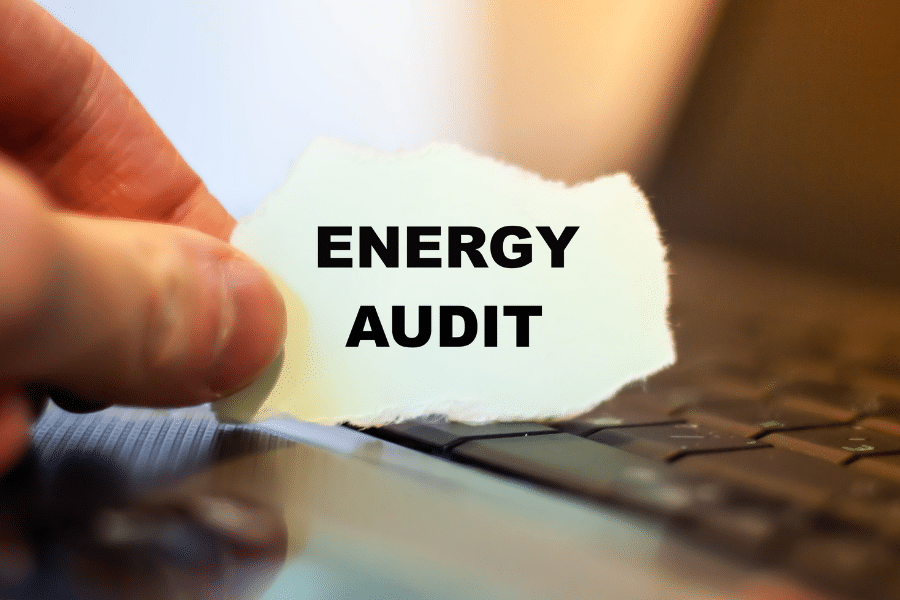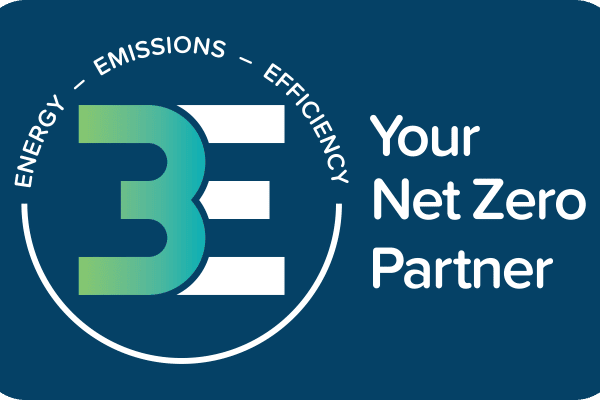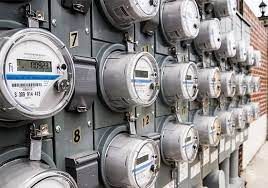Energy Audits: a best practice guide for businesses and organisations
The rampant rise in energy costs for large energy users and the seemingly evergreen demands placed on them by their various stakeholders to reduce greenhouse gas emissions has contributed to a significant increase in demand for energy advisory services, energy auditing and Energy Audit reports. For many organisations, an Energy Audit is the first step taken to gain an understanding of current energy utilisation and possibly identify areas of wastage and opportunities to conserve energy and reduce operating costs. Energy Auditing and the common procurement process for implementation, is not a sure-fire way to achieve guaranteed energy efficiency outcomes – it’s only a starting point.
The Energy Audit should not be the final deliverable, but only one of several stages along the journey towards economic and environmental sustainability in your business or organisation. One of the reasons for getting an energy audit is to get a basic understanding of the energy utilisation, energy costs and energy saving opportunities within your organisation. Energy Auditing is meant to assist a business or government organisation understand its current situation in relation to energy usage and energy efficiency, and provide some guidance on which areas to focus resources and investment. Ultimately, the success or failure of an Energy Audit not only relies on what happens next, but also how.
In this post, we examine what energy auditing is all about and how the conventional approach to implementing an energy savings project can be a big mistake. We also give some top tips to maximise the value you get from an energy audit.
- What is energy auditing / energy audit?
- Types of energy audits and which one is right for your organisation
- What’s involved in energy auditing and typical areas of investigation
- Why energy audits don’t translate to guaranteed energy efficiency outcomes: Disadvantages of poor procurement practices
- Common practice versus best practice procurement for energy efficiency
- Our Top 5 recommendations when considering an energy audit
What is energy auditing / energy audit?
An energy audit is designed to help you identify the most practical and cost effective options to reduce your organisation’s energy consumption and costs. An energy audit is conducted by a qualified and independent energy consultant and is often the first step towards reducing your energy usage and costs. The terms energy audit, or energy auditing are interchangeable but ‘Energy Audit’ is the official industry term and it refers to an assessment conducted to the Australian and New Zealand Standards (AS/NZ 3598 series).
Which Energy Audit is right for you?
There are three types of energy audits – Type 1, Type 2 and Type 3 – ranging in detail and level of accuracy. Each type can help organisations understand how energy is utilised within their facilities and identify possible energy conservation measures or energy saving opportunities.
Type 1 Energy Audits are a basic energy audit or assessment for your facilities providing a lower level assessment of energy use and energy saving opportunities. It is useful as a first step investigation into cost-effective energy saving opportunities, however the level of accuracy is typically ± 40 per cent.
Type 2 Energy Audits provide a more detailed assessment of your pattern of energy usage and a more comprehensive energy saving and costing analysis. It includes an increased scope of assessment and greater detailed descriptions of relevant energy efficient technology. It is intended for sites that have some knowledge of energy efficiency and energy management and require a detailed assessment of opportunities to reduce their energy consumption. Type 2 Audits typically have a degree of accuracy of ± 20 per cent.
Large energy users concerned about escalating energy prices and utility bills – particularly industrial plants, manufacturing facilities, hospitals, universities, hospitals, commercial office buildings and large format retail properties – would benefit more from a Type 2 energy audit than a Type 1 energy audit report.
A Type 3 Energy Audits are a precision subsystem audit with greater detail and precise measurement of energy usage and costs. This type of audit involves a stricter requirement for data accuracy and typically includes sub-metering of plant and equipment over a certain period of time (usually 12 months). This type of energy audit is a lengthy process (may take up to 18 months to finalise the report) and much more cost intensive than type 2 and type 1 audits.
The type of energy audit that’s right for your organisation depends on how much detail and accuracy is required as well as the time frame and budgetary restraints. Overall, organisations are mostly in favour of Type 2 Energy Audits, as they cover sufficient detail in a relatively short period of time for executive management to formulate a business case and consider funding an energy efficiency retrofit project.
Energy Audits are powerful tools but there are however, some drawbacks to procuring an Energy Audit to Australian Standards
What does an energy audit entail?
Energy Auditing is the process of reviewing and analysing an organisation’s facilities/ sites in terms of energy usage and energy costs, but can also include a review of current energy tariffs to ensure there are no overcharges and thorough checks for any kind of energy wastage that may be present.
In general, the investigations that form the basis of energy auditing include:
- Energy consumption analysis of utility bills
- Apportioning energy consumption to end use areas
- Analysing trends and anomalies
- Observing and reviewing specific plant and equipment to establish energy use profiles
- Energy saving analysis
- Identifying, analysing and providing recommendations of viable energy saving opportunities
Data sources required for energy auditing
- Visual observations from site visit
- Energy billing data
- Interviews with operational personnel
- Visual inspections of the building materials and building services
- Operating practices in place at the time of the audit
- Engineering drawings where available
Energy Saving Recommendations
An energy audit would typically detail and quantify each energy saving opportunity, including anticipated energy savings and implementation costs.
Energy Savings Estimates
- All costs and savings are presented in a summary table.
- Saving estimates are based on energy rates as listed in the utility bills unless otherwise stated. This unit cost is derived from utility billing information.
- Savings estimates are not necessarily cumulative.
- Savings estimates are typically accurate to within ± 20% (for Type 2 Energy Audits).
Certain “energy audits” carried out for the specific purpose of developing a proposal to implement a performance-based energy savings project are usually calculated to ± 0% accuracy, especially when the service provider is prepared to offer guarantees in terms of energy savings.
Ongoing Cost Savings Estimates
- The ongoing cost saving is the sum of energy savings estimates and any potential maintenance cost savings. Please note that the maintenance cost savings in energy audits are derived by calculating the benefit of replacing existing equipment with long life and energy efficiency alternatives. Budget cost estimates do not include associated consulting fees or in-house time, if applicable.
- Savings recommendations are not necessarily cumulative.
- Increasing the lighting efficiency implies a reduced heat load on the air conditioning, which has not been included in the calculations.
Greenhouse Gas Emission Savings Estimates
The greenhouse gas emissions savings is based on the GHG factors from the National Greenhouse Accounts (NGA) Factors – July 2017. In VIC this is 1.17 kg CO2-e/kWh for electricity and 51.53 kg CO2-e/GJ for gas.
Implementation Cost Estimates
There is nothing wrong with energy audits, however the major disadvantage of getting an energy audit done is that it typically encourages a prescriptive procurement process
Disadvantages of Energy Audits and Poor Procurement Practices
In the energy services sector, there’s a big disconnect between Energy Auditing and Energy Efficiency…
Energy Auditing and Energy Auditors has been around for many years, however more recently, demand for energy consultants has increased as a consequence of spiralling energy costs.…Why? Well, senior executives are painfully aware that utility costs have nearly doubled over the last couple of years and therefore seek external expertise to identify ways to reduce their utility bills. Energy Consultants naturally offer their energy auditing services in order to investigate the energy usage and overall efficiency of general plant and equipment throughout a facility. Energy Auditors can certainly provide valuable insight and key recommendations via the energy audit report, however most energy consulting companies don’t offer or specialise in the design and implementation of energy saving solutions.
In the energy services sector, there’s a big disconnect between Energy Auditing and Energy Efficiency as businesses and organisations are typically left to their own devices to design and implement the energy saving opportunities identified in the energy audit report. There is nothing wrong with energy audits, however the major disadvantage of getting an energy audit done is that it typically encourages a prescriptive procurement process when an organisation wants to implement energy saving solutions identified in the energy audit report. The issue is not with the energy audit standards but with the procurement model that typically follows an energy audit.
A prescriptive procurement process is when the client specifies which energy saving solutions identified in the Energy Audit Report are to be implemented and how they should be implemented.
Either the client sources quotes from suppliers directly or releases a tender whereby suppliers are invited to submit a proposal based on the prescribed criteria and scope of works. In most instances either approach does not always lead to the best possible outcome and the client assumes all technical risks and performance risks of each energy conservation measure they’ve prescribed. In this scenario, comparisons of prospective vendors are usually done on pricing alone and while the client may save money by choosing the ‘cheapest quote’, they may also overlook implementation and technical issues that will compromise safety and performance outcomes that will ultimately cost more time and more money to resolve.
When it comes to design and implementation of energy saving solutions, organisations should compare vendors based on proposed outcomes and performance measures (i.e. energy savings). Wherever possible, have vendors provide guarantees and measurement and verification of results in terms of actual savings and provide warranties on labour and parts. These assurances help reduce risk of the energy savings project failing to meet expectations and sustainability targets. A Tier-1 energy services company (ESCO) typically has the resources and expertise to provide such guarantees and warranties of all energy saving solutions implemented (assuming that ESCO is the primary contractor) compared to specialist suppliers of each solution operating independently from each other.
Another common problem with the prescriptive approach that usually follows an energy audit is the procurement of multiple contractors to design and install solutions. For example, if an energy audit recommends LED Lighting and Solar PV as viable energy conservation measures, then an organisation is likely to engage a specialist lighting company and another Solar PV company to install each respective solution. There are of course exceptions to this, especially when the selected vendor specialises in multiple technologies, but as the scope of works expands to more complex energy conservation measures requiring specific mechanical or electrical engineering expertise, then there will be additional contractors and sub-contractors to manage / liaise with.
Managing and coordinating multiple contractors to install various solutions can:
- place severe strain on internal resources,
- increase project complexity which can lead to project delays and cost-blowouts
- increase risk of failure to achieve stated outcomes
Energy audits can however be advantageous to an organisation IF they engage a single point of contact performance-based energy services company. A performance-based energy services company typically focuses on providing guaranteed outcomes in terms of energy savings; this is usually achieved through provision of integrated services including detailed facility studies (“Energy Audits”), scoping and design of energy conservation measures, implementation and commissioning, integration of energy analytics software with building management systems, measurement and verification and providing ongoing energy management services. In other words, the ESCO is the primary contractor that’s responsible for all sub-contractors and can deliver far more than just an energy audit report, but actually implement and monitor each solution and be held accountable for the results.
Don’t just get another energy audit report: Get Guaranteed Energy Savings with Ecosave. Discover how and learn more by talking to an energy solutions manager today.
Prescriptive vs Performance-based Procurement
Organisations are encouraged to move to a performance-based mindset and procurement approach when requesting an energy audit by adopting a holistic view and results-oriented perspective to achieving energy efficiency. Start with the end in mind.
Our top recommendations when considering an energy audit.
- Choose an independent energy services company to conduct your energy audit.
If an energy consultant or energy service company is also one that sells a particular product then be wary of any biased information related to that energy conservation measure. It’s safer to proceed with an energy services company that doesn’t sell any products at all, that way you can be assured that the energy saving recommendations are free from any bias or ulterior motives. - Work with a Tier-1 energy services company with expertise and experience in your industry. Further to the first tip, make sure you work with an energy services company that caters to the needs of organisations in the same industry as you.
- Don’t just ask for an Energy Audit – ask for a detailed Energy Efficiency, Generation and Sustainability Investment Report.
The Energy Audit should not be the final deliverable, but only one of several stages along the journey towards economic and environmental sustainability. One of the reasons for getting an energy audit is to get a basic understanding of the energy utilisation, energy costs and energy saving opportunities within your organisation. However, you should expect more from an energy audit. A quality energy audit should not only provide a detailed and holistic view of all energy saving opportunities but also estimated implementation costs, savings and on return on investment expectations. A quality energy audit report should include recommendations on which energy conservation measures to prioritise and outline a procurement strategy specific to your organisation’s budgetary and return on investment criteria. The more specific and tailored the audit can be to what’s important for your organisation, the more meaningful and valuable it becomes. - Expect an implementation proposal from your energy consultant or energy services company to design and construct the energy conservation measures identified in the energy audit. Again, the energy audit is not the final deliverable and there should be a clearly defined plan and proposal to execute the recommendations identified in the energy audit. Therefore, there is a risk involved in choosing an energy consultant that provides nothing but energy audits to Australian standards as there is no follow up or follow through to implementation. The onus is on the client to decipher the energy audit and determine next steps. On the other hand, there is a clear advantage in choosing an Energy Audit provider with the resources and industry experience to deliver an energy audit and an implementation proposal – one that’s developed to match your specific budgetary and return on investment criteria. Together, the energy audit and the project proposal creates a clear path to effective implementation which can save time and resources.
- Find a single-point-of-contact provider.
As stated above, an energy audit is just the beginning and only one piece of the energy puzzle. Work with a company that offers a full-suite of integrated services including energy advisory / energy consultancy, project implementation and energy management services. Engage a provider that can do the site assessments and deliver quality energy audit reports, design and implement energy efficiency upgrades and provide ongoing monitoring and energy management services.
Ecosave is a leading energy services company that specialises in integrated services for holistic energy saving solutions. At Ecosave, our promise to you simple: we guarantee energy savings. Click here to read client testimonials from large reputable organisations across government, manufacturing, education, financial services and health & aged care sectors.
If you have any questions or require an Energy Audit with a difference – Call Ecosave today on 1300 55 77 64
Other articles you may find interesting:
- Energy savings strategy to solve high power bill problem
- How organisations save money and resources through energy efficiency
- What is an energy services company (ESCO), what do they do and how can they help reduce operational and maintenance costs
- 7 reasons why businesses cannot afford to ignore sustainability
- How energy conservation projects can increase shareholder value and attract corporate investors
- Energy Conservation Measures that should be considered in an energy savings project





